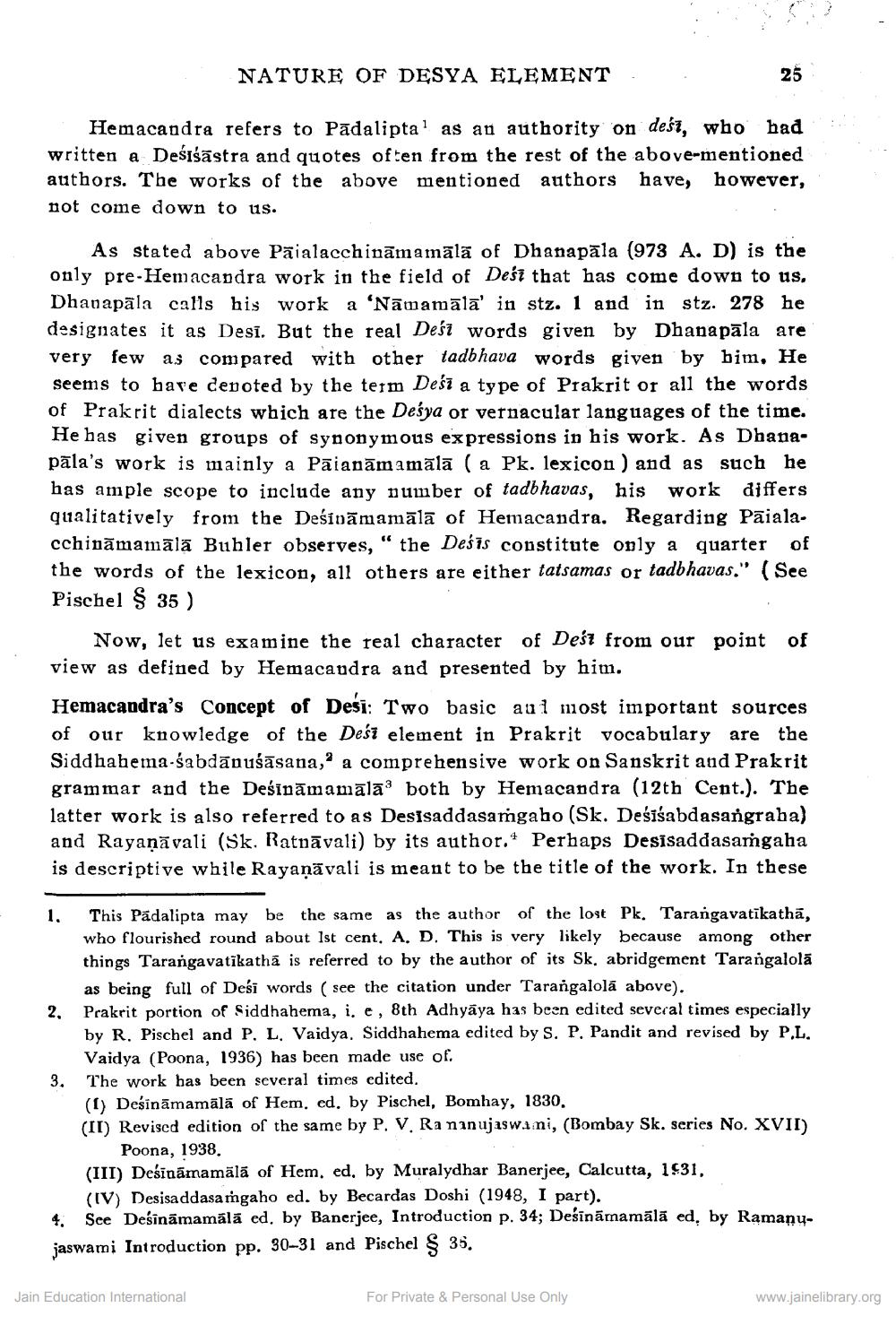________________
:
NATURE OF DESYA ELEMENT.
25
Hemacandra refers to padaliptal as an authority on desi, who had written a Deśiśāstra and quotes often from the rest of the above-mentioned authors. The works of the above mentioned authors have, however, not come down to us.
As stated above Păialacchināmamālā of Dhanapāla (973 A. D) is the only pre-Hemacandra work in the field of Desi that has come down to us. Dhanapāla calls his work a 'Nāmamāla' in stz. 1 and in stz. 278 he designates it as Desī. But the real Deść words given by Dhana pāla are very few as compared with other tadbhava words given by bim, He seems to have denoted by the term Deśī a type of Prakrit or all the words of Prakrit dialects which are the Deśya or vernacular languages of the time. He has given groups of synonymous expressions in his work. As Dhanapāla's work is mainly a Pāianāmamālā ( a Pk. lexicon ) and as such he has ample scope to include any number of tadbhavas, his work differs qualitatively from the Deśivāmamālā of Hemacandra. Regarding Pāiala. cchināmamālā Buhler observes," the Deśīs constitute only a quarter of the words of the lexicon, all others are either tatsamas or tadbhavas." (See Pischel § 35 )
Now, let us examine the real character of Dest from our point of view as defined by Hemacandra and presented by him.
Hemacandra's Concept of Desi: Two basic aut most important sources of our knowledge of the Deść element in Prakrit vocabulary are the Siddhahema-sabdāpuśāsana,' a comprehensive work on Sanskrit and Prakrit grammar and the Deśināmamālā both by Hemacandra (12th Cent.). The latter work is also referred to as Desisaddasamgabo (Sk. Deśiśabdasangraha) and Rayaņāvali (Sk. Ratnāvali) by its author. Perhaps Desisaddasamgaha is descriptive while Rayaņāvali is meant to be the title of the work. In these
1. This Padalipta may be the same as the author of the lost Pk. Tarangavatikathā,
who flourished round about 1st cent, A. D. This is very likely because among other things Tarangavatīkatha is referred to by the author of its Sk, abridgement Tarangalolā as being full of Desi words ( see the citation under Tarangalolā above). Prakrit portion of Siddhahema, i, e, 8th Adhyāya has been edited several times especially by R. Pischel and P. L. Vaidya. Siddhahema edited by S. P. Pandit and revised by P.L. Vaidya (Poona, 1936) has been made use of. The work has been several times edited. (1) Desināmamālā of Hem, ed. by Pischel, Bomhay, 1830. (IT) Revised edition of the same by P. V. Ranunujaswini, (Bombay Sk. series No. XVII)
Poona, 1938. (III) Deśīnāmamālā of Hem, ed. by Muralydhar Banerjee, Calcutta, 1931,
(IV) Desisaddasamgaho ed. by Becardas Doshi (1948, I part). 4. Sce Desināmamála ed. by Banerjee, Introduction p. 34; Desināramālā ed. by Ramanyjaswami Introduction pp. 30–31 and Pischel § 35.
Jain Education International
For Private & Personal Use Only
www.jainelibrary.org




